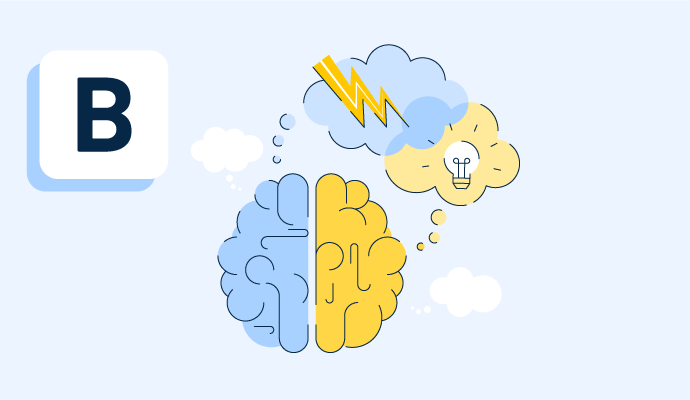What is brainstorming?
Brainstorming is an ideation method teams use to generate creative ideas and potential solutions to problems. During a brainstorming session, team members contribute ideas spontaneously and sometimes rapidly to develop a wide range of new and original ideas. While individuals can brainstorm alone, it is typically a group activity.
Many teams use visual collaboration platforms to communicate and collaborate in real time while conducting a brainstorming session in a remote environment. These tools include features like whiteboarding, diagramming, sticky notes, commenting, and conferencing for effective and innovative collaboration.
Types of brainstorming techniques
Most brainstorms involve capturing ideas, discussing them, and choosing which to pursue. However, brainstorms come in many forms, and specific types exist for various needs. Some of the most common types of brainstorming techniques are:
- Brainwriting: Participants write down their ideas in a brainwriting session instead of sharing them verbally. After everyone has a chance to put their thoughts on paper, participants pass their papers to the left or right, and the recipient adds to the ideas or comes up with new ones. This process continues for as long as a team needs. Then, the group chooses and commits to the strongest ideas.
- Rapid ideation: Time is of the essence in a rapid ideation brainstorm. With this technique, the facilitator provides context at the beginning of the session and then sets a time limit for participants to write down as many thoughts or ideas as possible. Teams can choose the time limit that works best to make these sessions most effective.
- Figure storming: Some teams use the figure storming technique to think outside the box and consider new perspectives. In figure storming, the group chooses a well-known figure not in the room, such as a celebrity or fictional character, and tries to answer how that person might solve the problem.
- Round robin: When conducting a round robin brainstorm, teams form a circle and share ideas one by one. The facilitator records all thoughts so the team can evaluate them once they reach the end of the circle. This method works well for allowing everyone to share.
- Stepladder technique: This brainstorming style combines group and individual decision-making while encouraging team members to contribute uninfluenced. First, the facilitator shares a topic with the whole team. Then, everyone leaves the room except for two team members, and they discuss their ideas. One by one, the team members enter the room and share their thoughts with the group before the entire team engages in a discussion.
Benefits of brainstorming
Brainstorming is necessary for problem-solving through idea generation and creativity. Below are some of the key benefits teams can expect from conducting various types of brainstorms:
- Creating space for diverse perspectives: Brainstorming allows all individuals to bring their unique and varied perspectives to the table. Participants from different departments and backgrounds can offer multiple viewpoints encouraging teams to think differently and pursue great ideas.
- Generating many ideas in a short period: When teams need a creative solution quickly, brainstorming can help them come up with a high volume of ideas. This is particularly beneficial when attempting to solve complex issues as more heads come together to produce various solutions.
- Helps reduce dominant opinions: Some team members are naturally more outspoken than others, so they may be able to share their thoughts and ideas readily. However, letting a small minority of voices dominate decision-making and team direction becomes problematic and biased.
- Builds camaraderie and early buy-in: Teams that solve problems together and contribute to the solution early in the process build a vested shared interest in the outcome. Group brainstorming allows teams to engage in camaraderie and view themselves as stakeholders with valued opinions, adding to the overall success of the work.
Brainstorming best practices
Teams should follow a general set of best practices to get the most out of a brainstorming session. These include:
- Creating a judgment-free zone: The purpose of brainstorming is to explore ideas and new ways of thinking, which means a judgment-free zone is a must. Facilitators should encourage out-of-the-box thinking and ensure all participants can share their ideas openly without fear of criticism.
- Focusing on quantity and not quality: When it comes to brainstorming, the more ideas, the better. Teams should prioritize generating as many ideas as possible and avoid stopping to assess the plausibility of each idea along the way.
- Encouraging teamwork and idea building: Brainstorming isn’t about bringing forward the best idea in the room, but instead, working together to combine ideas and find the best possible solutions. Teams should reward and encourage effective collaboration and remind participants to work together throughout the session.
- Documenting everything: Identifying and committing to a documentation method before the discussion is necessary. Capturing an audio recording of the session, using mind mapping software, and photographing sticky notes and whiteboards are common ways to log brainstorming meetings.
Ready to get started? Learn how to make a mind map to elevate brainstorming workshops.

Alyssa Towns
Alyssa Towns works in communications and change management and is a freelance writer for G2. She mainly writes SaaS, productivity, and career-adjacent content. In her spare time, Alyssa is either enjoying a new restaurant with her husband, playing with her Bengal cats Yeti and Yowie, adventuring outdoors, or reading a book from her TBR list.




















